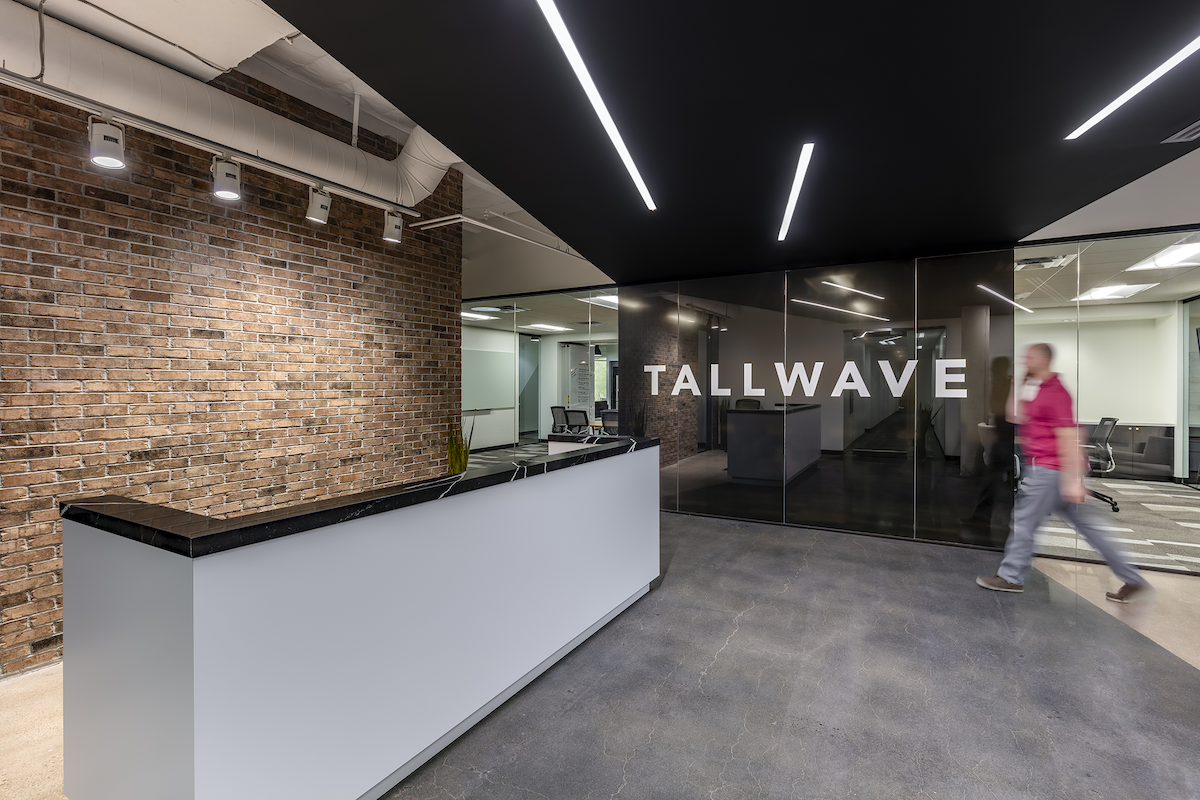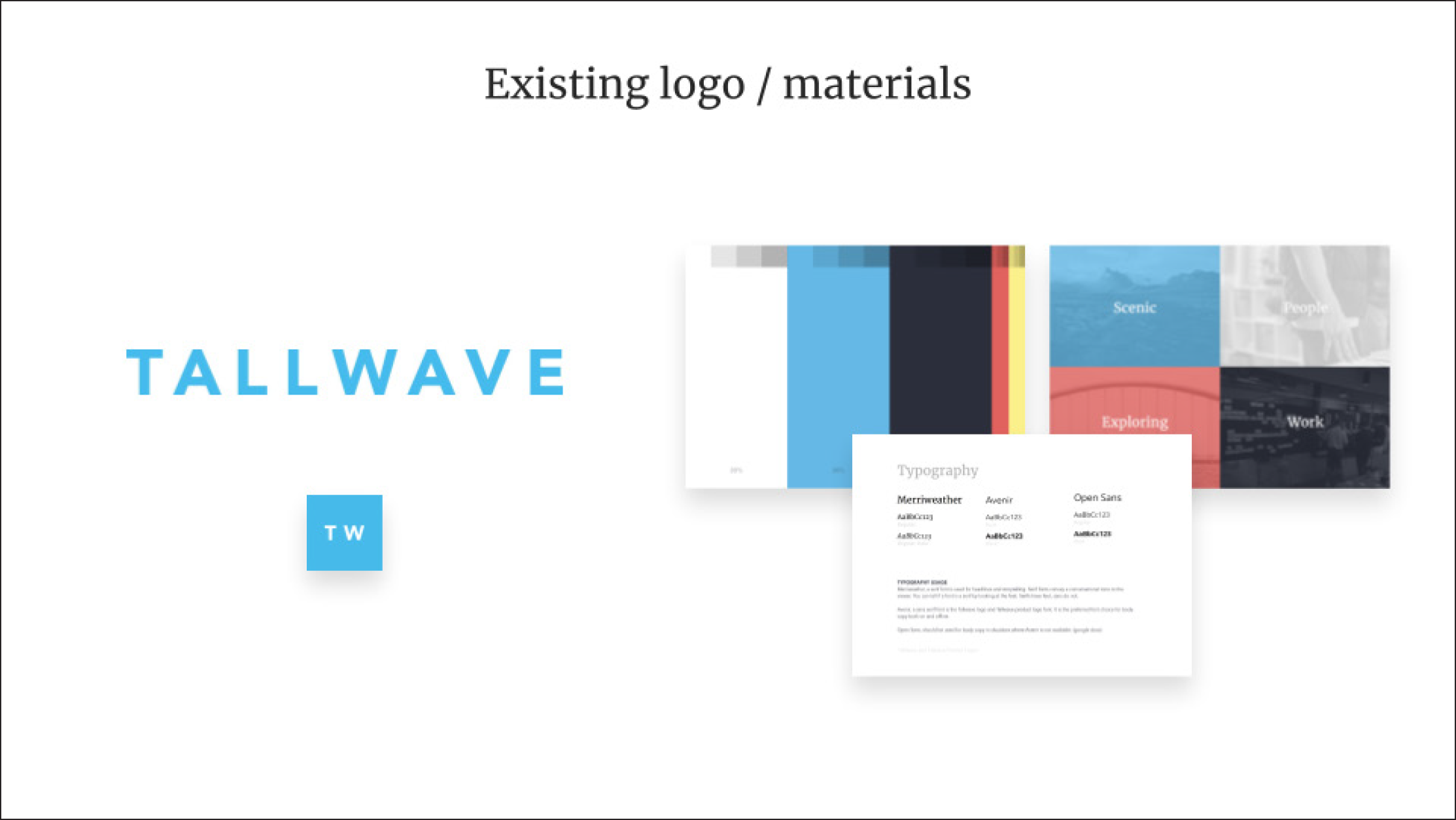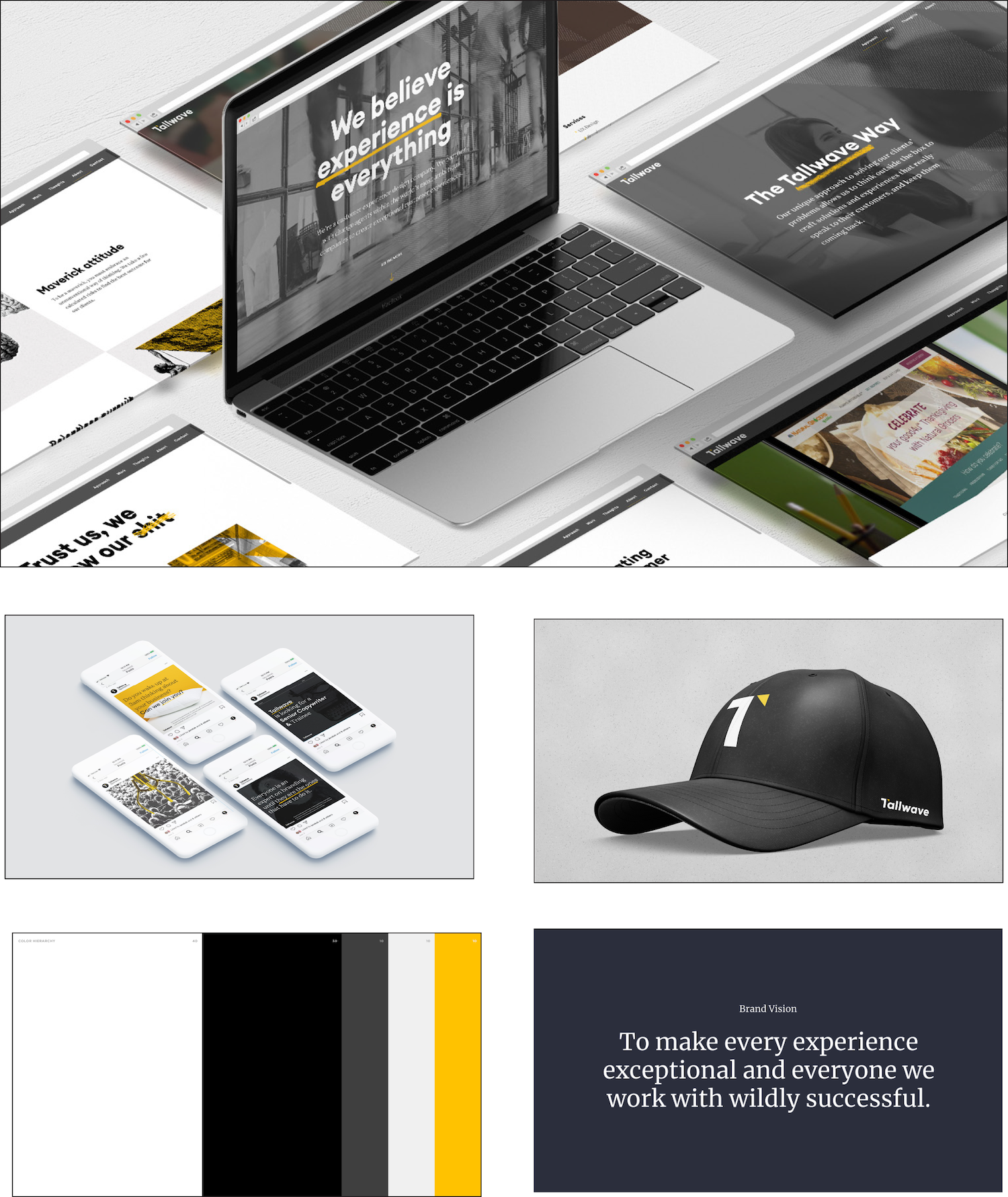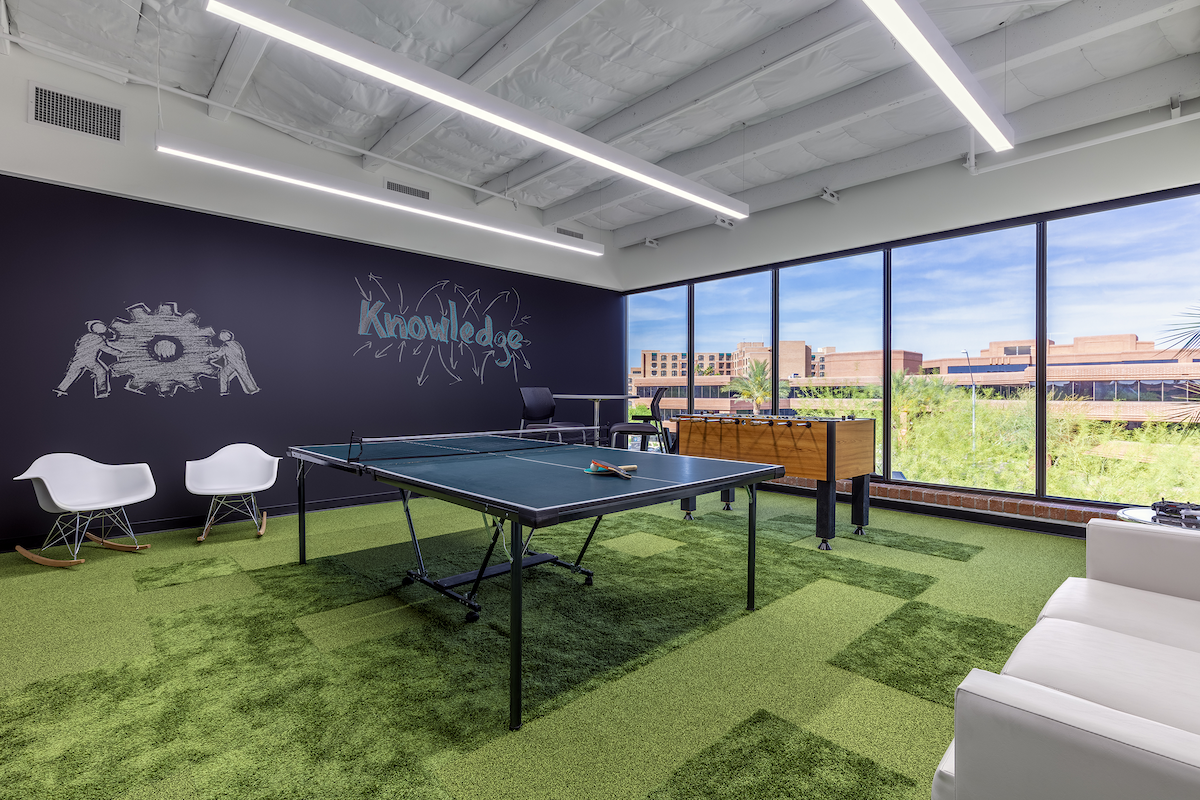Tallwave: Using a year of lockdowns & uncertainty to uplevel their brand

Let’s walk back in time to 2019. Tallwave, named one of Inc. Magazine’s fastest growing companies for three (now four) years in a row, was growing and experiencing tremendous success. Nearing 10 years since opening its doors, Tallwave had already conquered major business milestones – first growing their partnerships to bring innovative concepts to market from startups to Fortune 100 brands, and later acquiring companies including 29th Drive (a UX design company) and Ethology (a digital marketing services company) to expand their footprint and services.
But as the Tallwave team worked tirelessly to exceed client expectations, create an incredible culture and surpass revenue goals, something was beginning to take shape. After years of growth and continued success, Tallwave was ready to take on a new challenge in 2020.
A clear throughline organically appeared in everything they did: The importance of customer experience. They realized that the key to continued relevance, innovation and growth was through a humanistic approach to understanding and shaping the customer experience (CX), both for Tallwave’s clients and Tallwave itself.
It’s a testament to a healthy, happy client base that no Tallwaver was laid off during this time. And of course the rebrand looks kickass.
With this newfound clarity, Tallwave decided to refresh their brand and double down on their values, approach to innovation and point of view on customer experience, and prepared to grow their team with a new, larger office in Old Town Scottsdale (Fun fact: It has a hidden whiskey room!)

Then, COVID-19 hit. And Tallwave found itself with a big decision to make. Should they shy away from the rebrand strategy – perhaps postpone for a safer, more predictable time – or leap? As you probably guessed, they chose the latter.
Showing resilience that can only come from a clear vision and uncommon care, the team managed to make the rebrand a priority while simultaneously delivering results for clients in 2020. It’s a testament to Tallwave’s values and a healthy, happy client base that no Tallwaver was laid off during the pandemic. And, of course, the rebrand looks kickass.
Final visual system

I spoke with Jesus Ramirez, Vice President of Strategy & Innovation at Tallwave, to find out how they pulled off that rebrand in the midst of a very challenging time:
Tell me about your journey with Tallwave. I understand you were at the company in its early years, then you went away to San Francisco, and now you are back here in Arizona.
I joined the company in its early days. It was founded in 2009 by Jeff Pruitt, who had this vision of creating a company that would help startups and bold, ambitious companies bring innovative ideas to market. A vision to do really ambitious and disruptive things. Early on, working mostly with startups, we had an incubator, to launch and build out our own companies, an investment fund and an operating arm to work directly with startups and their founding teams. This was back in 2011 when I started, and we were very small, scrappy and resourceful, but we were also spread quite thin.
“We found that many of the same Design Thinking principles and lean startup methodologies were just as appealing and effective for larger companies as they were for startups.”
At some point, for the sake of our own sanity, we decided we needed to focus. We paused the incubator, spun out the fund and focused squarely on helping startups get to market and grow. During this period, we began working with larger companies. We found that many of the same Design Thinking principles and lean startup methodologies were just as appealing and effective for larger companies as they were for startups. While it wasn’t easy, through some trial and tribulations, we eventually found a model that worked. Along the way, what we’ve found is that there are a lot of really amazing entrepreneurs and change agents at larger companies as well. They’re the ones launching new initiatives, identifying opportunities, building new products, services and businesses, galvanizing their teams to transform and evolve their businesses, and always focusing on creating amazing experiences for their customers. These are the people that have the same boldness and spirit as the startup founders.
Original logo and new visual exploration

NOTES FROM THE DESIGN TEAM
“Start with a no-boundaries exploration.”
(AIGA) How did you initially deconstruct the branding—i.e., what were the issues that came up that you wanted to solve?
Here is what we set out to do when we started exploration…
Modernize the Brand: Create something clean and simple, with a limited color palette. Set the company up for next 10+ years of growth
Ideas based on New Brand Foundation: Explore how to represent concepts from brand work, visually. Execute towards the center of the thinking and the positioning
Cast a Wide Net: Consider a range of different conceptual directions and executions.
Establish & Communicate Design Principles: Use as a consistent guide throughout the decision-making process, for all deliverables and brand touchpoints
For Consideration: Wordmark vs pictorial symbolism. Evolution of current brand vs complete transformation. Start with no-boundaries exploration.

(Jesus): In 2014, I made the tough decision to leave Tallwave; I had an opportunity to run and lead an education technology company. It was not an easy decision, but it was one that I thought would be good for my personal development as a leader. And it was a great learning experience. I was fortunate to lead a great team that cared about improving the quality of post-secondary education. I joined the company in a challenging time, but was able to lead it through a series of big initiatives, including a major product redesign, a rebuild of our technology infrastructure and a full company rebrand—all of which led to a doubling of our monthly revenues and a big dropoff in customer churn. While I ended up parting ways after two years, it really highlighted for me the importance of having a strong and dedicated team, as well as unwavering culture and values embedded into the fabric of your company.
When I moved back to Arizona two years ago—I’m an Arizona native and have family here—I had no intention of rejoining Tallwave. However, I reconnected with Jeff and several leaders on the team, and was pleased to see how much the company had grown and matured during my time away. The company was now fundamentally at a different point in its growth trajectory and was grappling with new and exciting challenges. Since I had been gone, Tallwave had acquired a digital marketing agency called Ethology. Prior to that, when I was still at the company, we had also acquired a design firm called 29th Drive.
“We can really marry the strategy with the execution if we have those capabilities in house, and provide way more value to the companies we work with.”
Our reason for acquiring these companies was that we were doing really strategic work, but would then hand our work off to them, and the design and strategy was falling flat. So we said to ourselves, okay, we can have a bigger impact if we’re more deeply integrated as a part of their implementation teams. We can really marry the strategy with the execution if we have those capabilities and provide way more value to the companies we work with. We can then build these core competencies directly into the companies and drive greater sustainable success in this way.

NOTES FROM THE DESIGN TEAM
(AIGA) What elements of the original logo did you feel needed to remain, and what elements were generated as a result of your overall audit of the branding?
(TW) There were actually a few things that we debated with respect to what to keep from our current brand. We played around with whether to make a complete departure or whether to keep it safe and create a subtle departure from the current brand.
“We explored a complete departure first.”
We explored a complete departure first. We really tried to embrace our core values and not be afraid of coming up with something completely different from who we were at the time. We discussed whether we should have a capital T or a lower-case t. We discussed whether the logo should be the word Tallwave or a cool mark with Tallwave beside it, we discussed whether we should do a play on the original Tallwave teal/blue or whether we should go completely different. We considered everything and in the end we have the result of all of that consideration.
While initially, we liked the idea of a complete departure and explored it wholeheartedly, we had discussions about how proud we are of Tallwave and of how far we have come and we wanted to recognize that this was more of a next step in our growth and maturity, rather than a complete do-over. We didn’t want to completely abandon who we have been. And there’s powerful meaning behind that little, subtle triangle, and we all backed that direction hands-down.
Aspects of the logomark:
- Geometric lower-case typeface: youthful, approachable, timeless; modernizes the brand; personality without the frills
- The title case of the T: a nod to the previous all-caps wordmark; restoring a sense of strength/authority
- The arrow/triangle: Upward momentum, Accelerating growth, Elevating experience (all parts of our brand foundation); 3 points representing: Our employees, The Customer, Our Clients
- Negative space below the arrow: Breaking away, Maverick, independent spirit, answers unknown
- The color gold: Independent thinking, Creativity, Curiosity
The custom illustrations we had been working on for social and blog posts were some of the elements of branding that remained with the rebrand. In addition, supportive brand elements were created to speak to the human-centric aspect of our brand platform (i.e. hand-drawn markings, subtle analog textures, and custom infographics/ process graphics).

NOTES FROM THE DESIGN TEAM
(AIGA) What processes did you use to keep the visual dialogue moving toward the current solution? How was this facilitated during COVID?
(TW) We would schedule internal meetings between key stakeholders/ decision-makers to walk through the thought process arriving at a visual solution. We were in constant communication and would conduct quick internal gut-checks within smaller groups just to get further alignment regarding direction and approach.
“We really went in with the intention of eating our own dog food.”
We really went in with the intention of eating our own dog food. We ran this project as we would for any of our clients. And due to that, we were able to really pay attention to our process, get meaningful feedback from stakeholders—not only about the work being done but about the process—as we moved along. Not much changed due to COVID. As a company, we transitioned to a virtual world fairly easily. We were already so digital and virtual with our clients that it wasn’t a huge feat for us. We just made sure that we met regularly, thought two steps ahead, included the right people at the right times, and prepared for our presentations. But you would do that for any project—in person or not.
We created our own design principles to keep us focused and ensure that we didn’t veer off track from our brand foundation, core values and our intentions. These were…
- Simple: Epitomize minimalism and modernism. Designing with restraint ensures durability and timelessness.
- Meaningful: Everything should have meaning and tie back to our purpose, pillars, and values (e.g. maverick).
- Memorable: When people see us, it should stick, creating a lasting feeling and memory.
- Distinctive: Set apart from the crowd, setting trends and not following them.
- Authentic: Be badass and bold, yet still approachable. Most importantly, be true to ourselves.
We revisited our Brand Vision consistently to ensure that we were staying on track: To make every experience exceptional and everyone we work with wildly successful.

(AIGA to Jesus) What convinced you to come back?
(Jesus) Well, one was the incredible vision, strength and ambition of the leadership team. Second, the amazing culture of the organization, how much focus and investment there is on a culture that values the personal and professional development of its people—and that focus persists. As I mentioned before, this became incredibly important to me during my time away from Tallwave. So it made it very easy for me to come back. That was a little under two years ago.
I was fortunate to be able to step back into Tallwave, and for the first year, really assess and help where I could add the most value and leverage. At some point, I started to settle into a role that oversees strategy and innovation as well as our brand and marketing.

“…then COVID happened—that was a curveball that really showed the resilience of the team.”
Late last year, we decided it was time to invest in our growth. At Tallwave, we help businesses reimagine what’s possible for their brand to drive growth and momentum. We decided it was time to do the same for ourselves. We wanted to re-energize our brand both internally, as well as in the market.
We started this effort, and then COVID happened—that was a curveball that really showed the resilience of the team. It took that resilience to achieve this comprehensive rebrand, because it was such a big, company-wide initiative! So many people contributed, from all our employees to our clients and partners. We forged ahead, working remotely, and launched our updated brand and website in August. I’m so proud of the team. It was no small feat and the team really knocked it out of the park.
NOTES FROM THE DESIGN TEAM
(AIGA) Was there a particular moment that you could share: something y’all discovered, or found hilarious, or made you change direction during this whole process?
(TW) One thing we discovered early in the design process was that different key decision-makers had different expectations. To narrow this down, we established and adhered to some design principles and keywords in an effort to align the feedback and serve as a beacon.
“We were trying to cram too much meaning into the work, which made it convoluted and hard to follow. We had to do a design principle check and change gears”
We would love to say that we didn’t change direction during the process, but it wouldn’t be a rebrand project if we didn’t. We had actually gone down quite a road of visual exploration when we were forced to take a step back and look at what we were doing. We were considering the brand foundation and all that was within that, but it actually turned out that we were taking TOO much into consideration. We were trying to cram too much meaning into the work which made it convoluted and hard to follow. We had to do a design principle check and change gears to ensure that we were keeping things crisper. It’s hard to keep things simple, memorable, and distinctive when you have so many meanings included in a concept. So, we had some really pointed discussions within the creative team and with our stakeholders to really truly understand where we needed to focus on for the visual brand. Once all agreed and had further clarification on that, we started our exploration over and I’m so glad we did.
Tallwave values diagram

(AIGA) Your new website illustrates The Tallwave Way, a diagram linking “heart, mind, and matter” to the values of empathy, business strategy, and craft—the core values of Tallwave. Further, these values are embedded and manifested in the company culture in four ways: 1) a maverick attitude, 2) relentless pursuit, 3) thoughtful rigor, and 4) selfless teamwork. Can you tell me how these values were uncovered and articulated within your company culture?
(Jesus) There are several aspects of our company culture that are embedded in our DNA. The first is what I would call “whole-heartedness” or “whole-humanness.” It’s an empathy-driven approach that applies to literally everything we do, with all the businesses we touch. Empathy not just for our clients, but also for our clients’ customers, as well as ourselves. This comes directly from our CEO. We talk constantly about wanting to make Tallwave a place that is memorable for all employees that come through here. We want it to be a place that impacts your whole life positively—not just your career. We’re interested in not just helping people grow professionally, but in becoming better versions of themselves, through working together. It’s no one single thing; it’s a culture that works to help great people continue to grow into better people. It is the investment we make in our people, for example, in times like COVID, granting random days off and understanding struggles. There is a radical transparency in our communication; a trust that we provide and give. The leadership group is intent on ensuring these stay in place. If there is one core theme that is crucial to the leadership group, it’s this: there is such a real care we have for our team, and it underpins everything we do.

The game room
Also, because we started off as a lean group working for startups, we developed certain ways of operating and seeing the world. When you work with startups, you have to be lean, agile, resilient, willing to blow things up and challenge the status quo. There is a certain amount of curiosity that everyone has at our company. Whether you just started or have been with the company for ten years, you can ask, you can challenge, and most importantly, you have the autonomy to really get to your answers and challenge things if you don’t think they make sense! So I think that is something that really comes from our roots.
“…you can ask, you can challenge, and most importantly, you have the autonomy to really get to your answers and challenge things if you don’t think they make sense!”
It’s kind of what we refer to as a collective maverick attitude. You need to be a little bit scrappy! Larger companies need to keep driving innovation and avoid complacency…it takes bold leaders to set a vision, articulate it to your teams, and most of all, replace fear with curiosity. Growth rewards people who can be comfortable with shapeshifting environments and embrace that environment—and have that drive and vision to lead teams with confidence.
How were you able to take care of COVID emergencies for clients, and roll out the brand at the same time?
It wasn’t easy, but it speaks to the grit and determination of our team. When we started the rebrand, we knew it was going to be a focal point of 2020. Even when things got difficult, we had that locked in as a business priority. We didn’t shy away from that. There is a tendency to shift focus entirely to clients, and supporting our clients was certainly a priority, but we were also disciplined enough to forge ahead with the rebrand, given its importance.
2020 was supposed to be all about realizing new growth, but with COVID, our world became more about sustaining current business. We were fortunate to have a great year and didn’t lay anyone off. We are incredibly proud and grateful for that. So now we are setting our sights on getting back to growth in 2021. And we have already positioned ourselves for this. We shored up our executive team by hiring a Vice President of People and Chief Financial Officer. Both are incredible leaders with lots of experience and live our values. And because another part of our growth strategy is a geographic expansion, we are looking at Dallas, and have sights beyond that as well. Ironically, COVID helped simplify the recruitment process, and we already have four employees in Dallas and are looking at opening an office there.
“We did get to enjoy the new space for six months, but yeah, I think the team misses it. We also miss our whiskey room and our game room.”

The whiskey room
What makes a virtual Tallwave day? And were you all sad to have to leave your brand new space in Scottsdale?
I think it’s more about how the current conditions have changed around “what makes a Tallwave day.” Like everyone else, we had to adopt changes in ways to communicate, with more asynchronous communication, synchronous video, and even asynchronous video! I’ll tell you, asynchronous video really forces you to be concise and be succinct about what you are going to say, and do it in a short amount of time… So, yeah, we are using a lot of collaboration tools like Miro and Mural, besides design tools we were already using. It’s so crucial right now to find ways to collaborate, share ideas and organize thoughts, especially for a creative team like ours. We’ve run multiple virtual workshops with our clients and have found new ways to problem solve and work together. I mean, we have such a talented and innovative team, and it’s fascinating to see the team constantly evolve, try new things, throw things out, latch onto one thing and take it in another direction, etc. How we’ve evolved during this time has certainly been organic in many ways.
Our space was part of the investment in growth. I think the team misses it. It’s still available, people come to whiteboard and brainstorm, etc.— it’s still an option to come to the space if you need to, under the guidelines set by the CDC, of course. We did get to enjoy the new space for six months, but yeah, I think the team misses it. We also miss our whiskey room and our game room. We’re looking forward to returning one day, until then, we’re good with how 2020 worked out.
Connect with Tallwave:
https://tallwave.com/
https://www.instagram.com/tallwave/
https://twitter.com/tallwave
https://www.facebook.com/Tallwave/
https://www.linkedin.com/company/tallwave/
